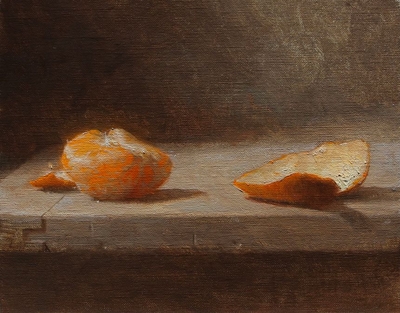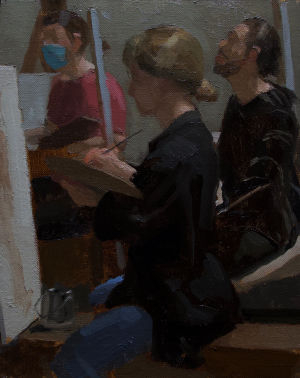As a "classical realist" who creates luminous landscapes, timeless still lifes and lifelike portraits, Jacob Collins operates outside the art world that usually receives media coverage. His work isn't on view in the supercool galleries of New York's Chelsea or at Art Basel Miami Beach. When his paintings are shown this April, it will be in Palm Beach, Fla., a haunt of the wealthy but an art backwater.
But that doesn't trouble Mr. Collins anymore. "I used to be mad at the art world and hate the art world, but it occurred to me that it would be like hating carnivals," he says. "The art world is a carnival; it's not my carnival. What is it to me if that pile of candy wrappers is called art?"
 "Clementine" by Collins |
To that end, last fall Mr. Collins became president of New York's Salmagundi Club, which was founded by artists and collectors in 1871 to champion representational art. Despite its illustrious past—with members including Augustus Saint-Gaudens, William Merritt Chase and Norman Rockwell—the club has long since lost influence in the art world. Revived, it might be a tool to match demand with supply for the kind of art produced at the school Mr. Collins founded, now known as the Grand Central Atelier.
There, in a skylighted warehouse space in Queens, Mr. Collins and other faculty teach students the old-fashioned precepts of painting, which emphasize direct observation, knowledge of anatomy, the use of live models, and years of practice in drawing techniques, perspective and color theory. Over the years, Mr. Collins figures that his academy has instructed about 400 students in a core four-year program, another 1,000 in part-time evening classes and 2,000 more in summer workshops. Online classes, begun when New York locked down because of the pandemic in spring 2020, are thriving too, he says.
Similar schools like the Florence Academy of Art in Italy and the New York Academy of Art are also training classical realist painters, exacerbating the demand problem. "You have all this talent making art but there are just not enough buyers," said Peter Trippi, the editor of Fine Art Connoisseur, a magazine covering traditional art. "The established art world has very little interest in this."
To change that, Mr. Collins plans to mount regular exhibitions at the Salmagundi Club, as well as panel discussions about aesthetics and collecting. "We'd like those collectors we admire to become leaders, to explain why they collect what they collect," he says. "In the avant-garde part of the art world, there's conversation about that. But for people who are interested in classical, traditional art, there's not a lot of it."
 "Chelsea Painting" by Collins |
But Mr. Collins believes he can find an audience. "There are a lot of disaffected people who would like a serious place to come and commune with others and discuss art," he says. I want to give those people someplace to go." Around the country, several regional galleries exhibit art like Mr. Collins's, and it sells. Yet New York, the epicenter of the art world and loaded with potential collectors, is "deeply underserved" in this area, Mr. Trippi says, adding that Mr. Collins's efforts "could be important."
Mr. Collins has his hopes in check. "I'm not looking to supplant the existing art market," he says, "but rather to create a parallel market. And to have a place where artists, patrons, collectors, writers and others can talk about this kind of art, and where we can develop a vocabulary and a grammar to talk about this kind of art."
Back in his own studio, Mr. Collins is focused on creating 15 paintings for the Palm Beach exhibition, to be held at Adelson Galleries. Until the end of last year he'd been completing commissioned works, but he has turned his attention to ideas that please him. At first, he was going to make all "fresh, vivid still lifes." Then he decided to add studio scenes of artists at work—making the kind of art that would win favor with the patrons he seeks to cultivate.

